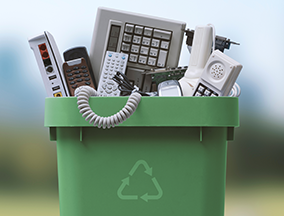Collected articles on
Home Improvement
Browse these selected articles to gain further insight on home improvement
All articles are pulled from ixact Crm
Recycling, Reusing or Disposing of Electronics
As consumers, it’s something we are not usually concerned about – until it’s time to dispose of them.
When that time comes, you might consider approaching local school organizations or community centers to see who might have a use for unwanted electronics, or contacting charity programs that collect outdated computers, tablets and cell phones for village schools in third-world countries.
If neither of those options is feasible, and you are convinced your devices will be of no use to others, consult with your local municipality to determine where and how to dispose of e-waste. They may have a program in place to safely dismantle and dispose of the equipment and could direct you to a drop-off site. You may also find that some local electronics retailers will accept old items for proper disposal, especially if you are a customer. Regardless of what you decide to do with old devices, make sure you have erased all personal data from the hard drive, memory chip and/or SIM card.
Home Energy Saving Tips that Won’t Leave You Shivering or Sweating
In fact, you probably won’t notice a difference of 2 degrees either way — and the savings can be substantial.
However, if you want to lower your bill even further each month, here are some additional tips that are relatively easy to implement:
- – Plug or fix the drafts. Even in newer homes, air filtration can occur at windows and doors. So, check around your home for drafts. Windy or cold days are the best days to check. Then, get any drafts you find repaired or, at least, temporarily plugged.
- – Check the attic. Heat rises and can escape through the attic. So, once a year, check the attic insulation for thin or bare spots. The insulation should be even across the space.
- – Get smart with your thermostat. Most thermostats these days are programmable. Program yours to reduce the heat at night and when you’re away in the winter. In the summer, be easy on the A/C during the day and save the cooling for nighttime.
- – Unused rooms? Close the vents to reduce heat or A/C. You might be surprised by how much that will lower your energy bill. (Think about rooms, such as a rec room, that you only use on weekends.)
- – Harness the sun. It’s free energy! Whenever possible, keep curtains open during cooler seasons to take advantage of this heat source, even on cloudy days. Do the opposite during hot summer days.
Try some of these ideas over the next couple of months. Then, look at the impact they’ve had on your energy costs.
Extending the Life of Cut Flowers
They instantly brighten any room. That is, of course, until they wilt and die. So how do you make cut flowers last as long as possible? Here are some ideas:
- – Cut the bottom of the stems before you put the flowers in the vase. An angled cut is best as this will enable the flower to draw in more water.
- – Add a fertilizer to the water. Most flower shops include a pouch with the order. Follow the directions carefully. Don’t use too much.
- – Make sure the vase is high enough to support the flowers. Too much strain on the stems will cause the flowers to die sooner.
- – After a couple of days, re-snip the stems. This will add an additional day or two to the life of the flowers.
- – Flowers last longer if you put them in the fridge (in water) overnight. That’s why florists store cut flowers in cool rooms.
Finally, watch the water level and top up as required. Older cut flowers will die quickly when starved of water — even for just a couple of hours.
